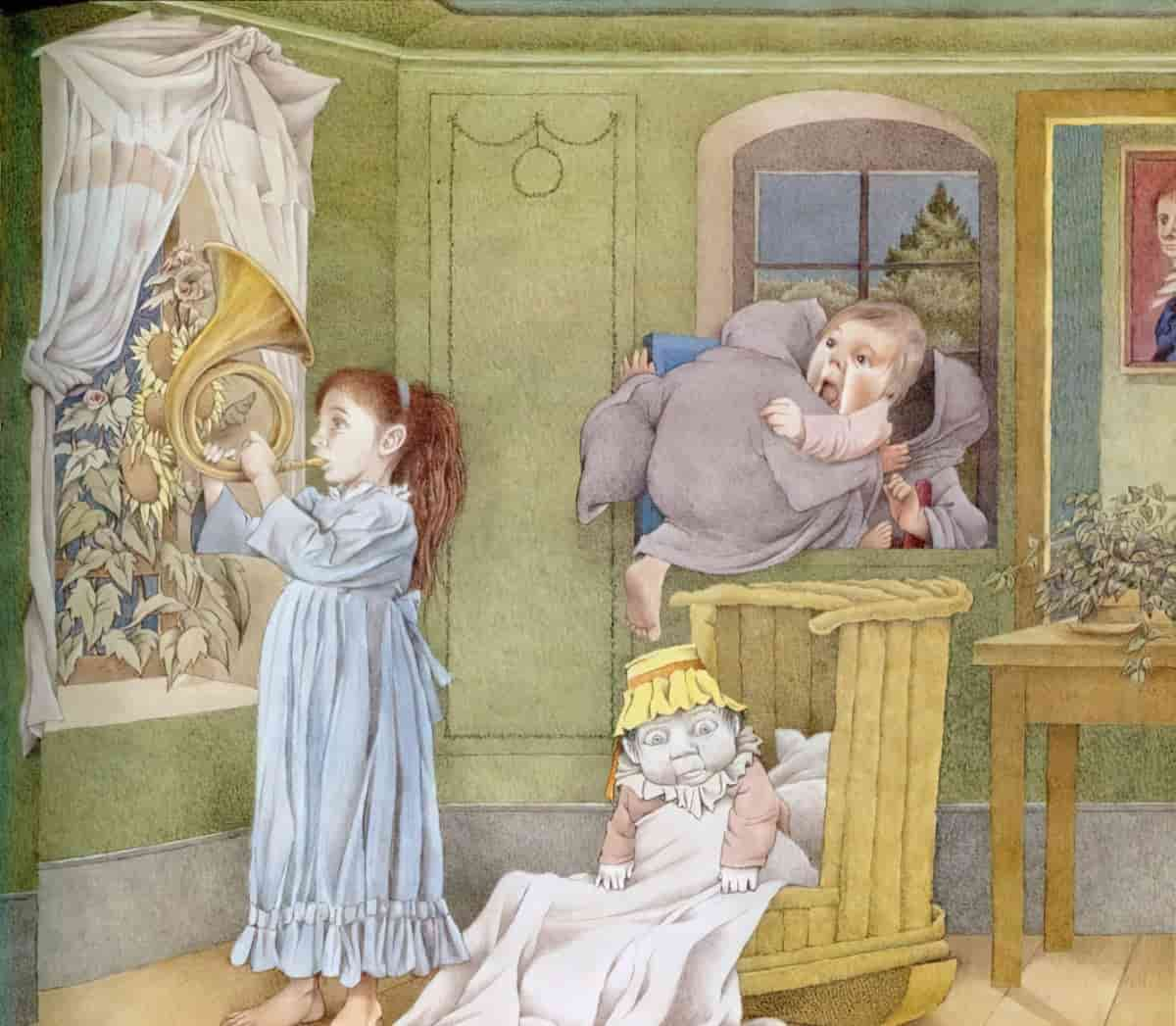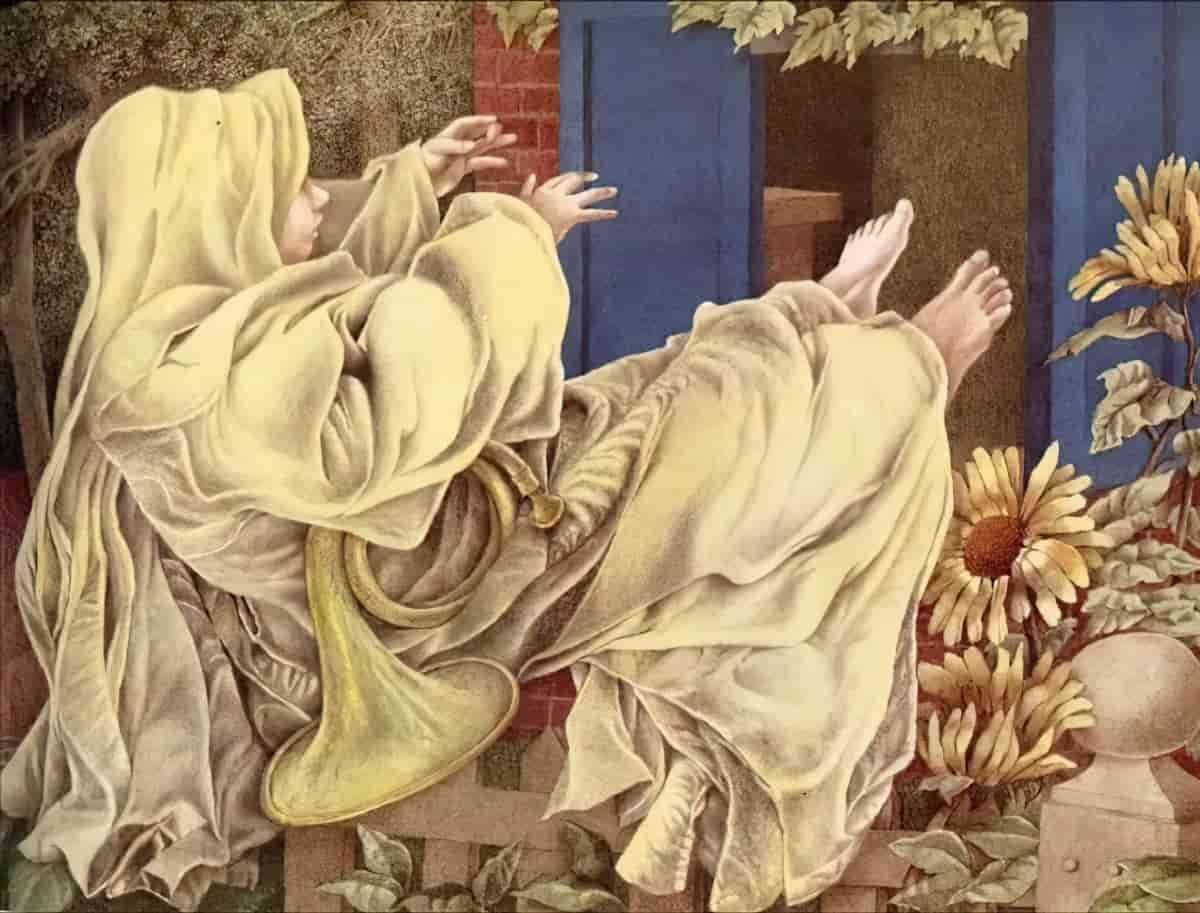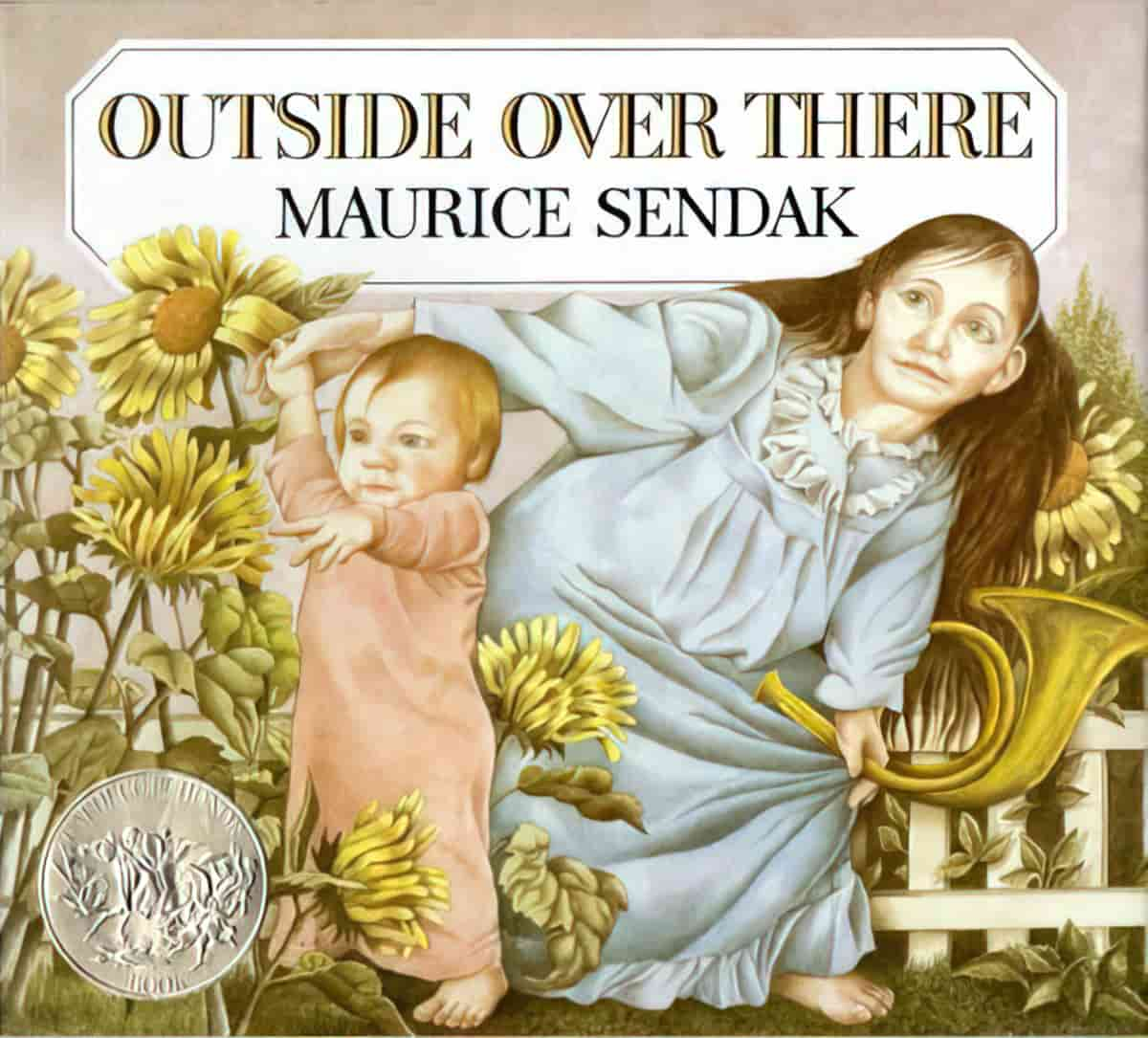This month I wrote a post on Teaching Kids How To Structure A Story. Today I continue with a selection of mentor texts to help kids see how it works. Today I look closely at a picture book classic by iconic American author/illustrator, Maurice Sendak. Outside Over There is a mythic journey of the imagination, with emphasis on atmosphere and emotion. It is a changeling story with the strong influence of fairy and folk tale.
Maurice Sendak’s most famous work is Where The Wild Things Are. Entire theses have been written about Where The Wild Things Are. I’ve summarised some of the key thoughts about that picture book myself, and have since noticed just how influential it was in its depiction of difficult feelings, previously taboo in stories for young readers.
Yet some children’s literature specialists believe Outside Over There is Sendak’s best work. In its publishing history, this picture book hasn’t always been marketed to children. This is one of those ‘children’s books’ which appeals to adults in a different, possibly deeper, way.
SETTING OF OUTSIDE OVER THERE
Outside Over There is Sendak’s best work by far. It marks the apogee of the picture book form, a simply profound story told in incantatory words and color drawings of stunning beauty. In creating the 359-word tale, Sendak is said to have been drawn to such childhood memories as the Lindbergh kidnapping and to have listened exclusively to Mozart to evoke the ambiance for the book’s Grimm setting in rural eighteenth-century Germany.
Jerry Griswold
I’m not surprised to learn that Sendak revised the text over 100 times. (I’m more surprised to learn he was counting.) The word arrangement is very strange, with adjectives following nouns, more reminiscent of a Romance language than English. Sendak must have been going for a foreign feel. I wonder if that foreign feel was retained in the translations.
The first time you read Outside Over There it might strike you as somewhat odd. It is not easy to find the rhythm and cadence immediately. It sometimes seems to stop when it should continue and continue when it should stop, it plays constantly with your ear’s expectations (if you expect a rhyme it never comes when you think it should, but when you least expect it, a bit after, a bit before or never). However, the more you read it and the more you make it yours, it is precisely those parts that were frustrating or odd the first times that strike you as so exceptionally beautiful and poetically forceful.
Sendak stretches sentences mercilessly. As someone reading out loud, he loses you for just a second and then takes you by the hand and returns you to your place gently, without you realising. The experience of reading it out loud is almost as if you were sent along an unknown path and on the way were provided with the tools required so as not to get lost.
We Read It Like This
The Lindbergh Kidnapping
If you listen to true crime podcasts and whatnot you may already know all about the infamous Lindbergh kidnapping of 1932. The following podcasters have done a Lindbergh episode:
- After Hours AM Crime of the Century Podcast
- Stuff You Missed In History Class
STORY STRUCTURE OF OUTSIDE OVER THERE
Outside Over There is another picture book with mythic structure. The whole thing might be Ida’s imagination but that’s neither here nor there. She is called to adventure when goblins steal her little sister. She goes after the sister, defeats the goblins in a big struggle, then arrives home a slightly changed person.
WHO IS THE MAIN CHARACTER?
A girl called Ida. She looks to be 8-10 years old. (Though her feet are unusually huge, imo.)
Ida’s red hair is pretty typical for a girl character who will enter into a fantasy world. (Does she also have green eyes? I just had a peer at my printed copy, and yes, she does.)
What is wrong with Ida?
Outside Over There is about jealousy and sibling rivalry. Sendak’s treatment of this subject might appear simple; instead, it is deeply accurate. The story belongs to Ida, a girl of some 9 years, and when it opens her baby sister has already arrived.
Jerry Griswold
Ida’s nightmarish fantasy that her baby sibling has been swapped out for a demonic character touches on a fear with crosses culture and eras. The idea that a close family member is not who you thought they were taps into a primal fear.

The changeling narrative can help us understand human psychology more generally. This particular fear has been brought up in discussions about why some parents choose not to vaccinate their children:
Honestly, read enough anti-vax stories and they all sound kinda similar to “MY Baby was fine and then one day a faerie swapped it out for a WEIRD baby” except for “faerie” sub “MMR jab.” People never change. People are always people, throughout human existence.
@Nicole_Cliffe
Naturally, Ida in this story isn’t thinking the first thing about vaccinations. Remember, Maurice Sendak never wrote his books with a child audience in mind — he just wrote them. I believe adults are more likely to worry about their children going missing than children are worried about their siblings going missing.
Adult fears about what might make children afraid are usually based on… adult fears.
We Read It Like This
When the little sister is replaced with an ‘ice baby’, this makes use of pretty obvious temperature symbolism. Sounds cheesy when you put it into words (as symbolism always does), but Ida feels cold inside.
WHAT DOES IDA WANT?
This question is simple when it refers to an object. A holy grail story, where the main character is after carrots or a jewel.
For a story like this, which is all about emotion, we need to dig deeper. Ida has psychological needs.
She needs attention. When she forgets to pay attention to her baby sister, she is mimicking the lack of attention her parents pay her. Maybe Ida will be taken away someday, too?
Ida’s parents have withdrawn: Papa is away at sea, Mama is lost in vacant thought and (pictorially) even the family’s protective German shepherd does not see the danger — goblins stealing up the lawn with Bruno Hauptmann’s ladder.
Jerry Griswold
OPPONENT/MONSTER/BADDIE/ENEMY/FRENEMY
The goblins who take Ida’s little sister, and who might capture her as well if she’s not careful.
WHAT’S THE PLAN?

In various cultures, walking backwards is thought to bring bad luck. (I’m sure that’s just the natural consequence of walking backwards… in which you will eventually run into something and hurt yourself!) In any case, Ida climbs out the window backwards which, in her fantasy, is the wrong thing to do. I think it symbolises ‘inattention’ and ‘not looking’ in this story. Ida’s real mistake, according to Ida, is not paying close enough attention to her little sister.
Ida is aerial and floats there over a haunting and mysterious landscape where a shepherd has fallen asleep unmindful of his flock and where below can be seen the dark, libidinous caves where the robber bridegrooms have taken her sister. But in going outside over there, Ida made “a serious mistake.” A clue comes to her in a riddle like song she hears floating over the water and sung by her sailor Papa: “If Ida backwards in the rain/would only turn around again/and catch the goblins with a tune/she’d spoil their kidnap honeymoon!” Ida’s mistake is to have gone out the window backward on her rescue mission; there is in this kind of reluctance and unwillingness, “so Ida tumbled right side round.”
Jerry Griswold
In a Gravity type plot, Ida doesn’t work out her own mistake. Instead she has to be told what to do by the voice of an absent and significant male figure, her father. The father tells her to turn around and catch the goblins with a tune.
BIG STRUGGLE
She finds herself smack in the middle of a goblin wedding and discovers that beneath their hoods these goblins all look like her baby sister. Slyly, she starts what Max in the Wild Things calls a “rumpus” and what Ida styles a “hubbub”; playing a captivating tune on her wonder horn, she sets the goblins dancing and sends them into such extremes of pleasure that they cannot control themselves or others. A kind of Pied Piper with a Zauberflöte, Ida churns the goblins’ revelry until they all dissolve into a watery stream. By this magic trick Ida separates the real baby from the goblin impostors and finds her own sister crooning in an eggshell.
Jerry Griswold
WHAT DOES THE CHARACTER LEARN?
It is a new Ida, then, changed and protective, who hugs her sister and takes her home.
Jerry Griswold
HOW WILL LIFE BE DIFFERENT FROM NOW ON?
There she meets Mama reading a letter to Ida from her Papa: “I’ll be home one day, and my brave, bright little Ida must watch the baby and her Mama for her Papa, who loves her always.” Just as for any child jealous of her sibling, Ida must be reassured by the last word of the letter; still, the fatherly advice is beside the point since we already know with Sendak, as the book concludes, that this “is just what Ida did.”
Jerry Griswold
Always check the final spot illustration in a picture book, even if it looks like it belongs more to the cover than to the story. It always tells you a little more about the story. Compare the final spot illustration to the almost identical one which opens the story. Spot the difference? There was a goblin crouching by the sunflowers but the goblin is gone now.
Receiving a letter from the father seems to have pulled Ida out of her slump, for now.
COMPARE AND CONTRAST
Sendak’s Other Picture Books
Like Wild Things and Night Kitchen, Outside Over There legitimizes taboo feelings by showing their simultaneity and reversibility. In some way, Ida’s playing the wonder horn evokes the goblins who kidnap her sister but also dissolves them so Ida can rescue her sister. Like Sendak’s other books, the pages of this one fold in upon each other so that felt withdrawal of the parents in its opening is answered with the reassurance of “always” love in its conclusion.
Jerry Griswold
As well as Sendak’s other dreamlike picture books, Griswold notices the influence of fairytale. Apart from similarities to The Pied Piper, mentioned above:
While Ida turns her back upon the baby and plays the musical instrument know as her “wonder horn,” the goblins steal into the nursery, kidnap her sister and leave a changeling made of ice. When Ida turns and embraces the baby it is, like most, drippingly wet; but when the changeling melts away. Ida discovers the goblins’ theft and in a rage turns maternal: putting on Mama’s cloak she sets out upon a rescue mission. She heads through the window to “outside over there.” This is the region known in dreams, where the Wild Things are, where the Night Kitchen is, where — to mention the place Rumpelstiltskin’s name is heard in the Grimm tale — the fox and the hare bid each other goodnight. And for Sendak, to whom this image is important, it lies on the other side of the window.
Jerry Griswold
Amanda Katz at NPR draws parallels between Outside Over There and The Juniper Tree.
Though it has none of the bald violence of “The Juniper Tree,” Outside Over There is also the story of a sister whose sibling is torn from her, and who fights to bring him or her back. Ida, Sendak’s big-eyed, horn-playing child heroine, is left with her mother and baby sister when her father goes off to sea. The family inhabits a pastoral wonderland, a kind of German Romantic landscape full of sailors and shepherds and sunflowers crowding, just a touch too aggressively, through the windows of a stately home.
Amanda Katz
In The Juniper Tree Katz explains
…a small boy is murdered by his stepmother, who then sets up her own even younger daughter to think she has killed him. Then she feeds the dead boy to his father, upon which the appalled, grief-stricken half-sister triggers a supernatural process that eventually brings her brother back to life and kills the evil stepmom. Then the three remaining family members rejoice and finish their dinner.
Changeling Stories
Coraline by Neil Gaiman is another changeling story, except the parents are swapped out. Traditionally it’s the child.
Even Harry Potter is a take on the changeling story. In 1940 George Orwell published a long essay called Boys’ Weeklies. Based on his own experiences at prep school, he talked about boarding school stories for children and their problematic ideology.
[Orwell] tries to understand why millions of children find stories set in boarding schools so spellbinding, the ‘snob appeal’ of this milieu is ‘absolutely shameless’. ‘The heroic characters all have to talk BBC,’ he observes, something that is equally true of the Potter novels.
In the same essay, Orwell touches on the ‘changeling fantasy’, a common trope of popular children’s literature, in which an apparently ordinary boy or girl turns out to be the child of an impossibly glamorous couple. Harry Potter falls squarely within this genre and that aspect of the novels also taps into the English obsession with ancestry. We are invited to condemn Voldemort for thinking ‘pure-bloods’ deserve special treatment yet to admire Harry’s impressive lineage.
Toby Young writing for The Spectator
That essay was written between the first and second golden ages of children’s literature, yet the massive success of Harry Potter and its descendants show that a great chunk of contemporary kids love the boarding school story, and its changeling narrative.
That changeling narrative is nowadays more commonly known as a Chosen One story, but its origin in changeling folktales is clear.
Fairies, trolls, elves, and devils kidnap human children, leaving their own demonic offspring in their place.
- Changelings: An Essay by D. L. Ashliman.
- The Changeling. A poem by James Russell Lowell.
- The Changeling. A ballad by John Greenleaf Whittier.
- Changeling Legends from the British Isles. Stories from England, Wales, the Isle of Man, Scotland, and Ireland.
- German Changeling Legends. Stories from German-speaking countries.
- Scandinavian Changeling Legends. Stories from Denmark, Iceland, Norway, and Sweden.
- How stories about children swapped from the fairy realm helped me navigate being transgender, KJM Stewart
A nixie is a fairy who started out as a kidnapped human child.
Influence On Labyrinth
Jim Henson’s Labyrinth movie was inspired by Outside Over There. But I’m not watching that again — it always freaked me out as a kid.
RELATED
Jerry Griswold has also explained how Outside Over There takes up Sendak’s identity as a gay male in a deeply symbolic way. (The hornpipe, that makes sailors wild beneath the ocean moon, the goblin wedding and spoiled honeymoon, the father’s disapproval, the man’s insistence that his offspring had made a ‘serious mistake’, the father’s identification of that mistake as being ‘backwards’ and his insistence about ‘needing to turn around again’.

